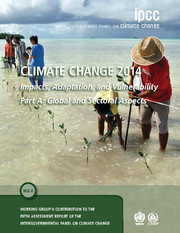 Climate Change 2014 – Impacts, Adaptation and Vulnerability: Part A: Global and Sectoral Aspects
Climate Change 2014 – Impacts, Adaptation and Vulnerability: Part A: Global and Sectoral Aspects Cross-Chapter Boxes
Published online by Cambridge University Press: 05 January 2015
Summary
Coral reefs
Coral reefs are shallow-water ecosystems that consist of reefs made of calcium carbonate which is mostly secreted by reef-building corals and encrusting macroalgae. They occupy less than 0.1% of the ocean floor yet play multiple important roles throughout the tropics, housing high levels of biological diversity as well as providing key ecosystem goods and services such as habitat for fisheries, coastal protection, and appealing environments for tourism (Wild et al., 2011). About 275 million people live within 30 km of a coral reef (Burke et al., 2011) and derive some benefits from the ecosystem services that coral reefs provide (Hoegh-Guldberg, 2011), including provisioning (food, livelihoods, construction material, medicine), regulating (shoreline protection, water quality), supporting (primary production, nutrient cycling), and cultural (religion, tourism) services. This is especially true for the many coastal and small island nations in the world's tropical regions (Section 29.3.3.1).
Coral reefs are one of the most vulnerable marine ecosystems (high confidence; Sections 5.4.2.4, 6.3.1, 6.3.2, 6.3.5, 25.6.2, and 30.5), and more than half of the world's reefs are under medium or high risk of degradation (Burke et al., 2011). Most human-induced disturbances to coral reefs were local until the early 1980s (e.g., unsustainable coastal development, pollution, nutrient enrichment, and overfishing) when disturbances from ocean warming (principally mass coral bleaching and mortality) began to become widespread (Glynn, 1984). Concern about the impact of ocean acidification on coral reefs developed over the same period, primarily over the implications of ocean acidification for the building and maintenance of the calcium carbonate reef framework (Box CC-OA).
A wide range of climatic and non-climatic drivers affect corals and coral reefs and negative impacts have already been observed (Sections 5.4.2.4, 6.3.1, 6.3.2, 25.6.2.1, 30.5.3, 30.5.6). Bleaching involves the breakdown and loss of endosymbiotic algae, which live in the coral tissues and play a key role in supplying the coral host with energy (see Section 6.3.1. for physiological details and Section 30.5 for a regional analysis).
- Type
- Chapter
- Information
- Climate Change 2014 – Impacts, Adaptation and Vulnerability: Part A: Global and Sectoral AspectsWorking Group II Contribution to the IPCC Fifth Assessment Report, pp. 97 - 166Publisher: Cambridge University PressPrint publication year: 2014
- 11
- Cited by
